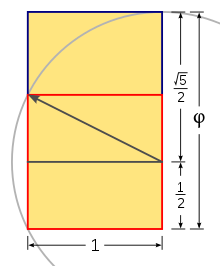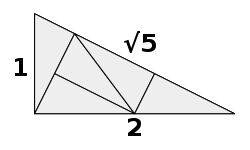| Rationality | Irrational |
|---|---|
| Representations | |
| Decimal | 2.23606797749978969... |
| Algebraic form | |
| Continued fraction | |
The square root of 5 is the positive real number that, when multiplied by itself, gives the prime number 5. It is more precisely called the principal square root of 5, to distinguish it from the negative number with the same property. This number appears in the fractional expression for the golden ratio. It can be denoted in surd form as:
It is an irrational algebraic number. [1] The first sixty significant digits of its decimal expansion are:
which can be rounded down to 2.236 to within 99.99% accuracy. The approximation 161/72 (≈ 2.23611) for the square root of five can be used. Despite having a denominator of only 72, it differs from the correct value by less than 1/10,000 (approx. 4.3×10−5). As of January 2022, its numerical value in decimal has been computed to at least 2,250,000,000,000 digits. [2]
Rational approximations
The square root of 5 can be expressed as the continued fraction
The successive partial evaluations of the continued fraction, which are called its convergents, approach :
Their numerators are 2, 9, 38, 161, … (sequence A001077 in the OEIS), and their denominators are 1, 4, 17, 72, … (sequence A001076 in the OEIS).
Each of these is a best rational approximation of ; in other words, it is closer to than any rational number with a smaller denominator.
The convergents, expressed as x/y, satisfy alternately the Pell's equations [3]
When is approximated with the Babylonian method, starting with x0 = 2 and using xn+1 = 1/2(xn + 5/xn), the nth approximant xn is equal to the 2nth convergent of the continued fraction:
The Babylonian method is equivalent to Newton's method for root finding applied to the polynomial . The Newton's method update, , is equal to when . The method therefore converges quadratically.
Relation to the golden ratio and Fibonacci numbers

The golden ratio φ is the arithmetic mean of 1 and . [4] The algebraic relationship between , the golden ratio and the conjugate of the golden ratio (Φ = −1/φ = 1 − φ) is expressed in the following formulae:
(See the section below for their geometrical interpretation as decompositions of a rectangle.)
then naturally figures in the closed form expression for the Fibonacci numbers, a formula which is usually written in terms of the golden ratio:
The quotient of and φ (or the product of and Φ), and its reciprocal, provide an interesting pattern of continued fractions and are related to the ratios between the Fibonacci numbers and the Lucas numbers: [5]
The series of convergents to these values feature the series of Fibonacci numbers and the series of Lucas numbers as numerators and denominators, and vice versa, respectively:
In fact, the limit of the quotient of the Lucas number and the Fibonacci number is directly equal to the square root of :
Geometry



Geometrically, corresponds to the diagonal of a rectangle whose sides are of length 1 and 2, as is evident from the Pythagorean theorem. Such a rectangle can be obtained by halving a square, or by placing two equal squares side by side. This can be used to subdivide a square grid into a tilted square grid with five times as many squares, forming the basis for a subdivision surface. [6] Together with the algebraic relationship between and φ, this forms the basis for the geometrical construction of a golden rectangle from a square, and for the construction of a regular pentagon given its side (since the side-to-diagonal ratio in a regular pentagon is φ).
Since two adjacent faces of a cube would unfold into a 1:2 rectangle, the ratio between the length of the cube's edge and the shortest distance from one of its vertices to the opposite one, when traversing the cube surface, is . By contrast, the shortest distance when traversing through the inside of the cube corresponds to the length of the cube diagonal, which is the square root of three times the edge. [7]
A rectangle with side proportions 1: is called a root-five rectangle and is part of the series of root rectangles, a subset of dynamic rectangles, which are based on (= 1), , , (= 2), ... and successively constructed using the diagonal of the previous root rectangle, starting from a square. [8] A root-5 rectangle is particularly notable in that it can be split into a square and two equal golden rectangles (of dimensions Φ × 1), or into two golden rectangles of different sizes (of dimensions Φ × 1 and 1 × φ). [9] It can also be decomposed as the union of two equal golden rectangles (of dimensions 1 × φ) whose intersection forms a square. All this is can be seen as the geometric interpretation of the algebraic relationships between , φ and Φ mentioned above. The root-5 rectangle can be constructed from a 1:2 rectangle (the root-4 rectangle), or directly from a square in a manner similar to the one for the golden rectangle shown in the illustration, but extending the arc of length to both sides.
Trigonometry
Like and , the square root of 5 appears extensively in the formulae for exact trigonometric constants, including in the sines and cosines of every angle whose measure in degrees is divisible by 3 but not by 15. [10] The simplest of these are
As such, the computation of its value is important for generating trigonometric tables. Since is geometrically linked to half-square rectangles and to pentagons, it also appears frequently in formulae for the geometric properties of figures derived from them, such as in the formula for the volume of a dodecahedron. [7]
Diophantine approximations
Hurwitz's theorem in Diophantine approximations states that every irrational number x can be approximated by infinitely many rational numbers m/n in lowest terms in such a way that
and that is best possible, in the sense that for any larger constant than , there are some irrational numbers x for which only finitely many such approximations exist. [11]
Closely related to this is the theorem [12] that of any three consecutive convergents pi/qi, pi+1/qi+1, pi+2/qi+2, of a number α, at least one of the three inequalities holds:
And the in the denominator is the best bound possible since the convergents of the golden ratio make the difference on the left-hand side arbitrarily close to the value on the right-hand side. In particular, one cannot obtain a tighter bound by considering sequences of four or more consecutive convergents. [12]
Algebra
The ring contains numbers of the form , where a and b are integers and is the imaginary number . This ring is a frequently cited example of an integral domain that is not a unique factorization domain. [13] The number 6 has two inequivalent factorizations within this ring:
On the other hand, the real quadratic integer ring , adjoining the Golden ratio , was shown to be Euclidean, and hence a unique factorization domain, by Dedekind.
The field like any other quadratic field, is an abelian extension of the rational numbers. The Kronecker–Weber theorem therefore guarantees that the square root of five can be written as a rational linear combination of roots of unity:
Identities of Ramanujan
The square root of 5 appears in various identities discovered by Srinivasa Ramanujan involving continued fractions. [14] [15]
For example, this case of the Rogers–Ramanujan continued fraction:
See also
References
- ^ Dauben, Joseph W. (June 1983) Scientific American Georg Cantor and the origins of transfinite set theory. Volume 248; Page 122.
- ^ Yee, Alexander. "Records Set by y-cruncher".
- ^ Conrad, Keith. "Pell's Equation II" (PDF). uconn.edu. Retrieved 17 March 2022.
- ^ Browne, Malcolm W. (July 30, 1985) New York Times Puzzling Crystals Plunge Scientists into Uncertainty. Section: C; Page 1. (Note: this is a widely cited article).
- ^ Richard K. Guy: "The Strong Law of Small Numbers". American Mathematical Monthly, vol. 95, 1988, pp. 675–712
- ^ Ivrissimtzis, Ioannis P.; Dodgson, Neil A.; Sabin, Malcolm (2005), "-subdivision", in Dodgson, Neil A.; Floater, Michael S.; Sabin, Malcolm A. (eds.), Advances in multiresolution for geometric modelling: Papers from the workshop (MINGLE 2003) held in Cambridge, September 9–11, 2003, Mathematics and Visualization, Berlin: Springer, pp. 285–299, doi: 10.1007/3-540-26808-1_16, MR 2112357
- ^ a b Sutton, David (2002). Platonic & Archimedean Solids. Walker & Company. p. 55. ISBN 0802713866.
- ^ Kimberly Elam (2001), Geometry of Design: Studies in Proportion and Composition, New York: Princeton Architectural Press, ISBN 1-56898-249-6
- ^ Jay Hambidge (1967), The Elements of Dynamic Symmetry, Courier Dover Publications, ISBN 0-486-21776-0
- ^ Julian D. A. Wiseman, "Sin and cos in surds"
- ^ LeVeque, William Judson (1956), Topics in number theory, Addison-Wesley Publishing Co., Inc., Reading, Mass., MR 0080682
- ^ a b Khinchin, Aleksandr Yakovlevich (1964), Continued Fractions, University of Chicago Press, Chicago and London
-
^ Chapman, Scott T.; Gotti, Felix; Gotti, Marly (2019), "How do elements really factor in ?", in Badawi, Ayman; Coykendall, Jim (eds.), Advances in Commutative Algebra: Dedicated to David F. Anderson, Trends in Mathematics, Singapore: Birkhäuser/Springer, pp. 171–195,
arXiv:
1711.10842,
doi:
10.1007/978-981-13-7028-1_9,
MR
3991169,
S2CID
119142526,
Most undergraduate level abstract algebra texts use as an example of an integral domain which is not a unique factorization domain
- ^ Ramanathan, K. G. (1984), "On the Rogers-Ramanujan continued fraction", Proceedings of the Indian Academy of Sciences, Section A, 93 (2): 67–77, doi: 10.1007/BF02840651, ISSN 0253-4142, MR 0813071, S2CID 121808904
- ^ Eric W. Weisstein, Ramanujan Continued Fractions at MathWorld



![{\displaystyle [2;4,4,4,4,4,\ldots ]=2+{\cfrac {1}{4+{\cfrac {1}{4+{\cfrac {1}{4+{\cfrac {1}{4+{{} \atop \displaystyle \ddots }}}}}}}}}.}](https://wikimedia.org/api/rest_v1/media/math/render/svg/3fd606420c218948d70d78ef2d0b3642625fbbfb)








![{\displaystyle {\begin{aligned}{\sqrt {5}}&=\varphi -\Phi =2\varphi -1=1-2\Phi \\[5pt]\varphi &={\frac {1+{\sqrt {5}}}{2}}\\[5pt]\Phi &={\frac {1-{\sqrt {5}}}{2}}.\end{aligned}}}](https://wikimedia.org/api/rest_v1/media/math/render/svg/3eac26c62df01d403a1b6dd636c4d748a4d251c4)

![{\displaystyle {\begin{aligned}{\frac {\sqrt {5}}{\varphi }}=\Phi \cdot {\sqrt {5}}={\frac {5-{\sqrt {5}}}{2}}&=1.3819660112501051518\dots \\&=[1;2,1,1,1,1,1,1,1,\ldots ]\\[5pt]{\frac {\varphi }{\sqrt {5}}}={\frac {1}{\Phi \cdot {\sqrt {5}}}}={\frac {5+{\sqrt {5}}}{10}}&=0.72360679774997896964\ldots \\&=[0;1,2,1,1,1,1,1,1,\ldots ].\end{aligned}}}](https://wikimedia.org/api/rest_v1/media/math/render/svg/40e42a64dc4089929abd2556f0085295e89f5d49)
![{\displaystyle {\begin{aligned}&{1,{\frac {3}{2}},{\frac {4}{3}},{\frac {7}{5}},{\frac {11}{8}},{\frac {18}{13}},{\frac {29}{21}},{\frac {47}{34}},{\frac {76}{55}},{\frac {123}{89}}},\ldots \ldots [1;2,1,1,1,1,1,1,1,\ldots ]\\[8pt]&{1,{\frac {2}{3}},{\frac {3}{4}},{\frac {5}{7}},{\frac {8}{11}},{\frac {13}{18}},{\frac {21}{29}},{\frac {34}{47}},{\frac {55}{76}},{\frac {89}{123}}},\dots \dots [0;1,2,1,1,1,1,1,1,\dots ].\end{aligned}}}](https://wikimedia.org/api/rest_v1/media/math/render/svg/b8afb3430510b5d3af4fdb42b1efc628b5f373d5)










![{\displaystyle {\begin{aligned}\sin {\frac {\pi }{10}}=\sin 18^{\circ }&={\tfrac {1}{4}}({\sqrt {5}}-1)={\frac {1}{{\sqrt {5}}+1}},\\[5pt]\sin {\frac {\pi }{5}}=\sin 36^{\circ }&={\tfrac {1}{4}}{\sqrt {2(5-{\sqrt {5}})}},\\[5pt]\sin {\frac {3\pi }{10}}=\sin 54^{\circ }&={\tfrac {1}{4}}({\sqrt {5}}+1)={\frac {1}{{\sqrt {5}}-1}},\\[5pt]\sin {\frac {2\pi }{5}}=\sin 72^{\circ }&={\tfrac {1}{4}}{\sqrt {2(5+{\sqrt {5}})}}\,.\end{aligned}}}](https://wikimedia.org/api/rest_v1/media/math/render/svg/d833578ec19eebfddfdbe0d596b4a7d9b6001b1f)


![{\displaystyle \mathbb {Z} [{\sqrt {-5}}]}](https://wikimedia.org/api/rest_v1/media/math/render/svg/a37499ef27234d8a67a65932184280bb17301312)




![{\displaystyle \mathbb {Z} [{\tfrac {{\sqrt {5}}+1}{2}}]}](https://wikimedia.org/api/rest_v1/media/math/render/svg/774cc09fcb62659f6f8efdd0455ec49411da4da1)

![{\displaystyle \mathbb {Q} [{\sqrt {-5}}],}](https://wikimedia.org/api/rest_v1/media/math/render/svg/e7b4049a7ae77352b9231d9b8511d6f9e4643b12)


![{\displaystyle {\cfrac {1}{1+{\cfrac {e^{-2\pi {\sqrt {5}}}}{1+{\cfrac {e^{-4\pi {\sqrt {5}}}}{1+{\cfrac {e^{-6\pi {\sqrt {5}}}}{1+{{} \atop \displaystyle \ddots }}}}}}}}}=\left({{\sqrt {5}} \over 1+{\sqrt[{5}]{5^{\frac {3}{4}}(\varphi -1)^{\frac {5}{2}}-1}}}-\varphi \right)e^{\frac {2\pi }{\sqrt {5}}}.}](https://wikimedia.org/api/rest_v1/media/math/render/svg/0ad3920d4a06f5410085a00c763762a581b84cf9)

